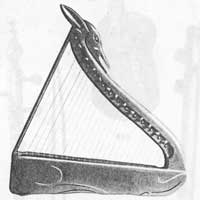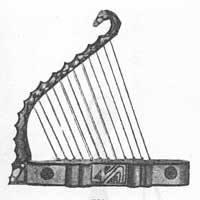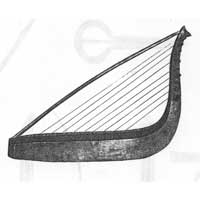4. The Republics and Autonomous Regions of Transcaucasia and North Caucasus
Soviet Caucasus is inhabited by many peoples belonging to different ethnic groups, and the musical instruments cultivated in that area, consequently, show a wide variety of types and forms. Along with instruments peculiar to one people only, there are instruments in the Caucasus, which occur, in the same form or with slight variations, in the musical practice of several peoples. Besides, some of the republics have a greater number of different instruments while others have fewer, but this cannot serve as an indication of the level of the development of instrumental music, for certain peoples, in the first place the Georgians, have been developing mainly vocal music.
The Georgian SSR.
- Chángi triangular harp with a body hollowed out of a piece of wood, a straight or slightly bent neck and six, ten or eleven strings of twisted horsehair. The most popular is the Svan type of the changi on which the 1st, 3rd and 5th strings are tuned to a major triad and the 2nd, 4th and 6th, to a minor triad.The instrument is played either in chords or by plucking individual strings.
The changi, whose tones are usually spoken of as "plaintive" and "sorowful", has from time immemorial heen used to accompany solo and choral singing. One or several changis are played mostly by women. lmproved changis constructed in Soviet times are encountued in some ensembles of Goergian folk instruments.
six-stringed: f – g – a – h – c1 – d1.
seven-stringed: e - f – g – a – h – c1 – d1
The Abkhazian ASSR
- Ayumaa triangular harp similar to the Georgian changi, with 14 horsehair strings. Formerly it was wide spread as an instrument on which singers played their own accompaniments.
The North-0ssetian ASSR and the South-0ssetian Autonomous Region.
- Duadastanon triangular harp with a hollowed body and arc-shaped neck usually terminating in a curved horse's head (or an auroch's head). The instrument has 12 diatonically tuned horsehair strings of which eight (treble) are white and four (bass) black.
The duadastanon was regarded as the instrument of heroes and only men were allowed to play it, accompanying the recitation of the Nart epic tales, as weIl as lyrical, love and children's songs.
7. The RSFSR. The Buryat ASSR, the Yakut ASSR, the Peoples of the Far East and of North East Siberia.
The peoples of the Buryat ASSR, the Yakut ASSR, the Far East and North-East Siberia belong to different ethnic groups: the Finno-Ugric, the Samoyed, the Turki, the Mongolian, the Tungus-Manchurian and the Palaeasiatic. Their folk music is predominantly vocal, instrumental music occupying a less prominent place. Only the Khants and the Mansis have relatively well-developed musical instruments, mostly plucked, with a large number of strings.
The Buryats, too, have a variety of instruments such as the bowed khur and khuchir, the wind instruments sur, limba and bishkur. Jew's harps, forged of metal, made of metal plates, and wooden, occur everywhere in Siberia.
Along with their national instruments, the peoples of these regions cultivate instruments borrowed from other nations.
Instruments of the Mansis.
- Tor-sapl-yukh plucked instrument with many strings, a kind of triangular harp. The body is hollowed out of a piece of wood, one end of it is bent upwards forming a neck, sometimes adorned with a carved bird's head. It has from five to nine (usually eight) strings producing a diatonic scale.
Today it is rarely encountered.
|
2 chángis  ayumaa ayumaa duadastanon duadastanon tor-sapi-yuck tor-sapi-yuck
|
